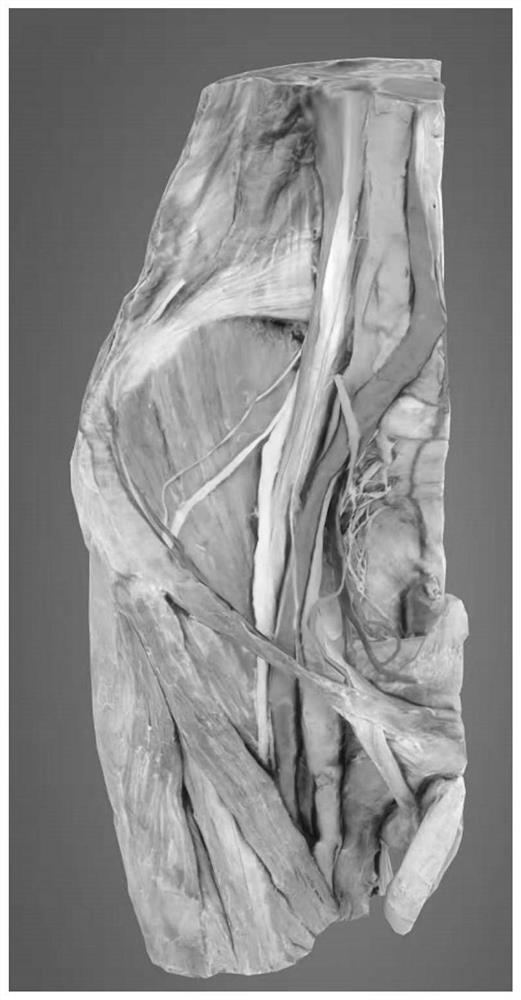Dyeing method for human body plasticized specimen blood vessels and nerves
A dyeing method and specimen technology are applied in the field of dyeing of blood vessels and nerves of human plasticized specimens, which can solve the problems of difficult long-term preservation and dull color, and achieve the effects of convenient long-term preservation, saving teaching costs, and strong sense of reality.
- Summary
- Abstract
- Description
- Claims
- Application Information
AI Technical Summary
Problems solved by technology
Method used
Image
Examples
Embodiment 1
[0024] Embodiment 1: as figure 1 As shown, a method for staining blood vessels and nerves of human plastination specimens includes the following steps:
[0025] 1) Specimen preparation: select plasticized specimens that need to display blood vessels and nerve structures, and deformed ones. In this embodiment, plasticized specimens of the head and face are selected.
[0026] 2) Dyeing agent configuration: select the required pigment toner, mix the pigment toner with epoxy resin AB glue, the pigment toner is made of red, yellow and blue pigment toner made from natural ore, and use 300 sieves For screening and use, the ratio of pigment toner to epoxy resin AB glue is 3:1.5:0.8, and then add a small amount of absolute ethanol to dilute to adjust to a suitable color depth;
[0027] 3) Specimen pretreatment: apply xylene on the surface of blood vessels and nerves, remove the excess glue on the surface of blood vessels and nerves, and after the xylene volatilizes completely, carry o...
Embodiment 2
[0031] Embodiment 2: as figure 1 As shown, a method for staining blood vessels and nerves of human plastination specimens includes the following steps:
[0032] 1) Specimen preparation: select plasticized specimens that need to display blood vessels and nerve structures, and lose shape. In this embodiment, the plasticized specimens of the pelvis are selected;
[0033] 2) Dyeing agent configuration: select the required pigment toner, mix the pigment toner with epoxy resin AB glue, the pigment toner is made of red, yellow and blue pigment toner made from natural ore, and use 300 sieves For screening and use, the ratio of pigment toner to epoxy resin AB glue is 5:2.5:1, and then add a small amount of absolute ethanol to dilute to adjust to a suitable color depth;
[0034] 3) Specimen pretreatment: apply xylene on the surface of blood vessels and nerves, remove the excess glue on the surface of blood vessels and nerves, and after the xylene volatilizes completely, carry out oxida...
Embodiment 3
[0038] Embodiment 3: A method for staining blood vessels and nerves of human plastination specimens, comprising the following steps:
[0039] 1) Specimen preparation: select plasticized specimens that need to display blood vessels and nerve structures, and deformed ones. In this embodiment, plasticized specimens of the head and face are selected.
[0040] 2) Dyeing agent configuration: select the required pigment toner, mix the pigment toner with epoxy resin AB glue, the pigment toner is made of red, yellow and blue pigment toner made from natural ore, and use 300 sieves For screening and use, the ratio of pigment toner to epoxy resin AB glue is 6:3:1.2, and then add a small amount of absolute ethanol to dilute to adjust to a suitable color depth;
[0041] 3) Specimen pretreatment: apply xylene on the surface of blood vessels and nerves, remove excess glue on the surface of blood vessels and nerves, and wash with H 2 o 2 Oxidative bleaching, where H 2 o 2 is H at 3g / L 2 o...
PUM
 Login to View More
Login to View More Abstract
Description
Claims
Application Information
 Login to View More
Login to View More - R&D
- Intellectual Property
- Life Sciences
- Materials
- Tech Scout
- Unparalleled Data Quality
- Higher Quality Content
- 60% Fewer Hallucinations
Browse by: Latest US Patents, China's latest patents, Technical Efficacy Thesaurus, Application Domain, Technology Topic, Popular Technical Reports.
© 2025 PatSnap. All rights reserved.Legal|Privacy policy|Modern Slavery Act Transparency Statement|Sitemap|About US| Contact US: help@patsnap.com


